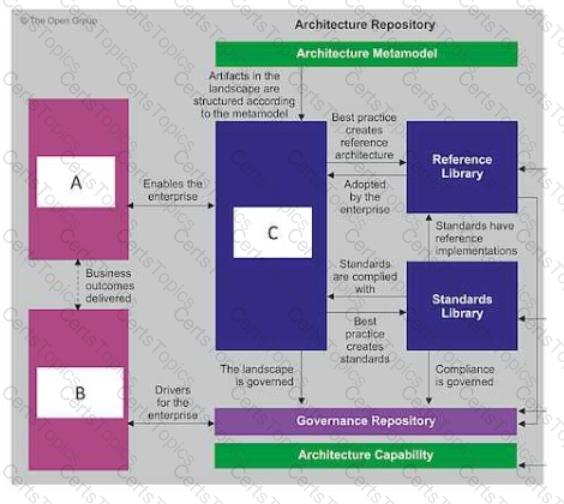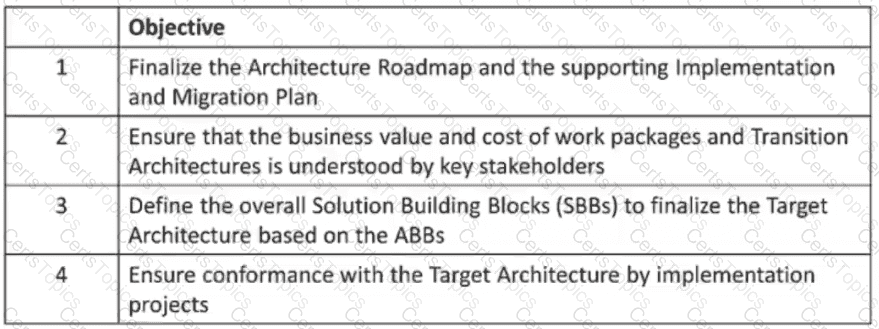What does the TOGAF ADM recommend for use in developing an Architecture Vision document?
Consider the illustration.

What are the items labelled A B and C?
Which of the following best summarizes the purpose of Enterprise Architecture?
How does iteration enable simultaneous operation of multiple ADM phases?
What provides context for architecture work, by describing the needs and ways of working employed by the enterprise?
Complete the following sentence. In the ADM, documents which are under development and have not undergone any formal review and approval process are called______ Documents which have been reviewed and approved are called ______
Which of the following best describes the purpose of the Architecture Roadmap?
Consider the following statement.
According to the TOGAF standard, a governed approach of a particular deliverable will ensure adherence to the principles, standards, and requirements of the existing or developing architectures.
Which deliverable does this refer to?
Which of the following best describes the need for the ADM process to be governed?
What is used to structure architectural information in an orderly way so that it can be processed to meet stakeholder needs?
What is defined as the effect of uncertainty on objectives?
Consider the following statements:
A whole corporation or a division of a corporation
A government agency or a single government department
A chain of geographically distant organizations linked together by common ownershipComplete the sentence. The TOGAF Standard considers these to be examples of:
Consider the following ADM phases objectives.

Which phase does each objective match?
What should be put in place through organization structures, roles, responsibilities, skills and processes to carry out architectural activity effectively?
Complete the sentence The Architecture Landscape is divided into levels known as__________________________.
Complete the following sentence. In the ADM documents which are under development and have not undergone any formal review and approval process are_______________.
Which statement best summarizes the TOGAF Content Framework?
Which of the following describes the practice by which the enterprise architecture is managed and controlled at an enterprise-wide level?
Which of the following is a purpose of creating a set of Architecture Principles?
Which statement best summarizes the TOGAF Content Framework?
Consider the following extract of the purpose of an ADM Phase:
Phase Output & Outcome / Essential Knowledge
? — “A set of work packages that address the set of gaps, with an indication of value produced and effort required, and dependencies between the work packages to reach the adjusted target.”
What ADM Phase is this?
Which deliverable is first produced in Phase A, also updated in Phase E, and helps the architect to understand the baseline and target for the enterprise?
Which statement about Requirements Management is most correct?
Which of the following are the four purposes that typically frame the planning horizon, depth and breadth of an Architecture Project, and the contents of the EA Repository-?
Within the Architecture Repository, what does the class of information known as the Architecture Capability include?
Complete the sentence. The purpose of the Gap Analysis technique is to _____.
Which of the following is a purpose of Phase A of the TOGAF ADM?
Complete the sentence. The purpose of Enterprise Architecture is to
Which ADM Phase includes initial implementation planning?
Consider the following statements.
1. All processes, decision-making, and mechanisms used will be established so as to minimize or avoid potential conflicts of interest.
2. More effective strategic decision-making will be made by C-Level executives and business leaders.
3. All actions implemented and their decision support will be available for inspection by authorized organization and provider parties.
4. Digital Transformation and operations will be more effective and efficient.
Which statements highlight the value and necessity for Architecture Governance to be adopted within organizations?
How does an Enterprise (Architecture) Metamodel provide value?
Complete the sentence A set of architecture principles that cover every situation perceived meets the recommended criteria of_______________
What are the following activities part of?
. Risk classification
. Risk identification
. Initial risk assessment
Which section of the TOGAF template for Architecture Principles should describe the relationship to other principles?
What structural framework does the TOGAF Standard define to support the management, leverage, and storage of architectural work products?
In the ADM, what is the name for documents that are not finished and not approved?
Complete the sentence The Enterprise Continuum provides methods for classifying architecture artifacts as they evolve from________________________.
Consider the description.
The typical contents of the assessment include: an overview of project progress and status and project architecture/design.
Which form of assessment is described?
Which of the following best describes a purpose of the Gap Analysis technique?
Which one of the following classes of information within the Architecture Repository would typically contain a list of the applications in use within the enterprise?
Which of the following are two of the architecture domains that are considered as subsets of an overall Enterprise Architecture?
In the ADM, what is the name for a document deliverable that has completed a review and is approved?
Which of the following describes a purpose of Architecture Principles?